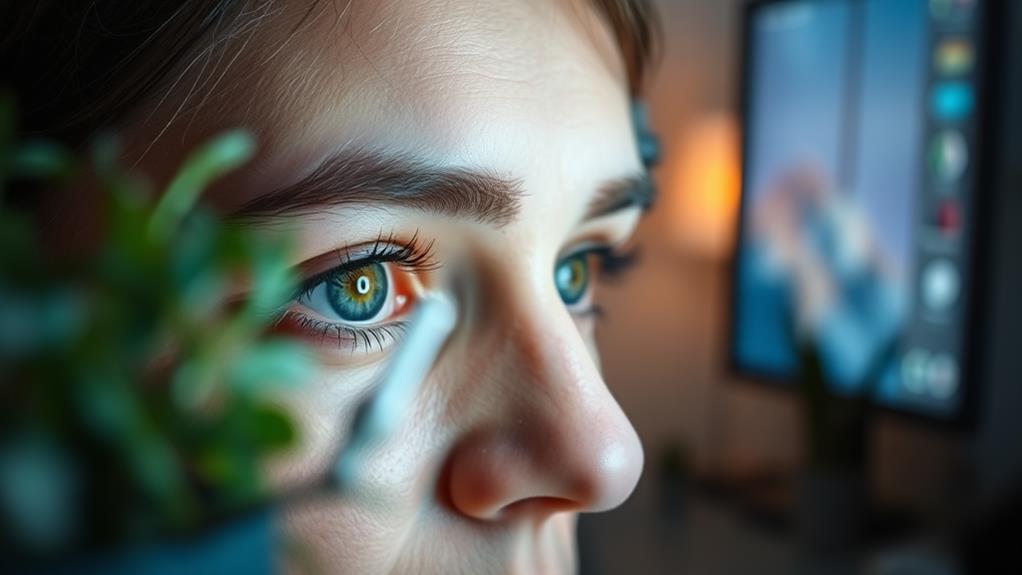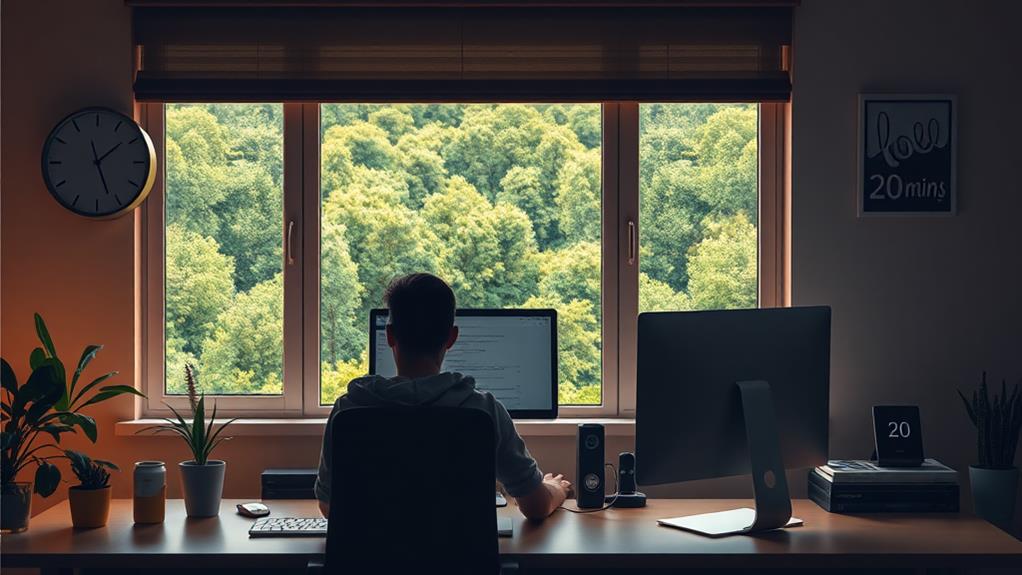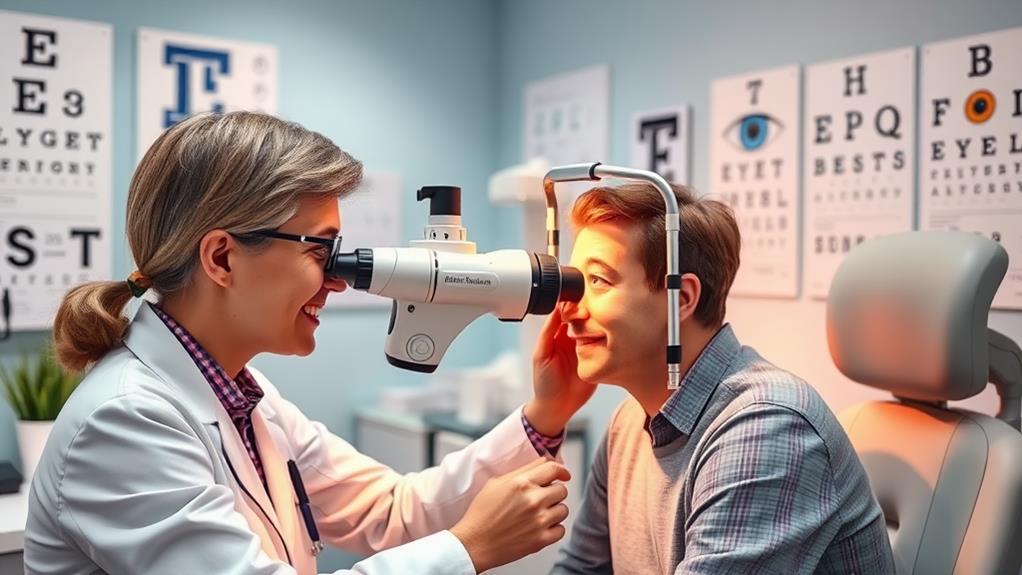As you spend more time on screens, it’s essential to prioritize your eye health. You might not realize how digital eye strain can affect your vision over time. Implementing simple strategies, like the 20-20-20 rule and adjusting your workspace, can greatly ease discomfort. But there’s more to take into account when it comes to optimizing your environment and habits for better eye care. Curious about the best practices you can adopt to protect your vision while staying connected?
Key Takeaways
- Follow the 20-20-20 rule: every 20 minutes, look at something 20 feet away for 20 seconds to relieve eye strain.
- Adjust screen brightness to match the surrounding light to enhance comfort and reduce glare.
- Maintain a distance of 20-30 inches from the screen to minimize eye strain and improve posture.
- Use anti-reflective coatings on glasses to decrease glare from screens and improve visual clarity.
- Ensure adequate lighting in your workspace, combining natural and artificial light to reduce eye fatigue.
Importance of Eye Health

Eye health is essential to your overall well-being, as it directly impacts your quality of life. When your eyes feel good, you can enjoy the world around you much better. You’ll notice the colors in nature, read your favorite books, and interact with friends and family without any hassle.
Taking care of your eyes isn’t just about seeing clearly; it’s also about feeling great every day. Good eye health helps you avoid discomfort and strain, which can make your days less enjoyable.
Regular eye check-ups are crucial because they catch problems early. You might think everything’s fine, but sometimes, issues are hiding. Eating a balanced diet rich in fruits and vegetables, especially leafy greens and carrots, can work wonders for your vision. Staying hydrated is important too, as it keeps your eyes moist and comfortable.
Don’t forget to protect your eyes from harmful UV rays when you’re outdoors. Wearing sunglasses can shield them from damage.
Understand Digital Eye Strain
Have you ever felt tired eyes after staring at a screen for too long?
Digital eye strain can sneak up on you, causing discomfort and making it hard to focus.
Let’s look at what causes this strain and the symptoms you should keep an eye out for!
Causes of Digital Eye Strain
Spending long hours in front of screens can lead to digital eye strain, a common condition that affects many people today. This happens when you focus on digital devices for too long without giving your eyes a break. Your eyes can get tired and dry, especially if you’re not blinking enough.
Another cause of digital eye strain is the blue light emitted by screens. This light can be harsh on your eyes, making it harder for you to focus. If your screen is too bright or too dim, it can also cause strain.
Sitting too close to the screen can make things worse, as your eyes have to work extra hard to see clearly. Poor posture while using devices can contribute, too. If you’re hunched over or looking down, it puts extra pressure on your neck and eyes.
Symptoms to Recognize
Digital eye strain can manifest through a range of noticeable symptoms that you shouldn’t ignore. If you’ve been using screens for a long time, you might feel some discomfort.
Common signs include dry eyes, where it feels like your eyes are scratchy or irritated. You might also experience blurred vision, making it hard to focus on your screen or read text. Headaches can pop up, especially after hours of staring at your computer or phone.
Another symptom is eye fatigue, where your eyes feel tired and heavy. You may even notice difficulty in concentrating, which can affect your productivity. If you find yourself squinting or rubbing your eyes more often, that’s a clear sign something’s not right.
Recognizing these symptoms early is super important. It’s your body’s way of telling you to take a break!
When you notice these signs, make sure to rest your eyes regularly. Remember the 20-20-20 rule: every 20 minutes, look at something 20 feet away for 20 seconds. Taking care of your eyes now will help you enjoy technology without discomfort later!
Follow the 20-20-20 Rule

Following the 20-20-20 rule is a simple yet effective way to reduce eye strain during long periods of screen time. You can easily remember this rule: every 20 minutes, take a break and look at something 20 feet away for at least 20 seconds. This little routine helps relax your eye muscles and gives them a much-needed rest.
Your eyes work hard when you’re staring at screens, so treating them kindly is essential. When you follow this rule, you can notice a difference in how your eyes feel. Instead of feeling tired or strained, you’ll likely find that they feel fresher and more relaxed. It’s like giving your eyes a mini-vacation!
To make it a habit, set a timer on your phone or use an app that reminds you to take breaks. You can even stretch or walk around a bit during those 20 seconds—your body will thank you too!
Optimize Your Workspace
Your workspace plays an essential role in maintaining eye health, so it’s important to set it up thoughtfully. Start by placing your computer screen about an arm’s length away. This distance helps reduce eye strain. Make sure the top of the screen is at or just below eye level. That way, you’ll naturally look slightly down at it, which is easier on your eyes.
Lighting is also key to a comfortable workspace. Use soft, natural light when possible, and avoid harsh overhead lights that can create glare. If you need extra light, consider using a desk lamp with an adjustable arm, so you can direct the light where you need it most.
Keep your workspace clutter-free and organized. A tidy area helps minimize distractions, allowing you to focus better. Don’t forget to take breaks, too! Stand up, stretch, and look away from your screen every once in a while.
Lastly, remember to adjust your chair for comfort. A good chair supports your back and encourages good posture, which can help your eyes feel more relaxed.
Adjust Screen Brightness

Adjusting your screen brightness can greatly enhance your comfort while working. When your screen is too bright, it can strain your eyes, making it tough to focus.
On the other hand, a dim screen can make it hard to see what you’re doing. Finding the right balance is key!
To adjust your screen brightness, start by checking your device settings. On most computers and tablets, you can find brightness controls in the display settings. Slide the brightness bar until it feels comfortable for your eyes.
If you’re using a smartphone, you can often swipe down from the top of the screen to access brightness controls quickly.
You might also want to take into account the time of day. Bright sunlight can wash out your screen, so you may need to increase brightness during the day.
In the evening, dimming your screen can help signal to your brain that it’s time to wind down.
Use Proper Lighting
Proper lighting plays an essential role in eye comfort and health, especially when you’re working on screens for long periods. Good lighting helps reduce glare and eye strain, making it easier for you to focus on your tasks.
When you’re setting up your space, try to use a combination of natural and artificial light. Position your screen so that it’s not facing a bright window or light source, which can cause reflections and make your eyes work harder.
Consider using desk lamps with adjustable brightness. Soft, warm light is usually the most comfortable for your eyes. You might also want to avoid overly bright fluorescent lights, as they can create harsh glare. Instead, opt for LED bulbs that offer a softer glow.
If you’re working in a dim room, make sure your screen brightness matches the surrounding light. This helps your eyes adjust comfortably.
Don’t forget to take breaks, too! Every 20 minutes, look away from your screen and focus on something 20 feet away for at least 20 seconds. This simple trick can keep your eyes feeling fresh and ready to tackle the next challenge!
Regular Eye Check-ups

Getting regular eye check-ups is super important for keeping your vision sharp and healthy!
These exams help you spot any changes in your eyesight early on, so you can take action if needed.
Plus, they’re a great way to make sure your eyes are in tip-top shape!
Importance of Routine Exams
Routine eye exams are essential for maintaining your overall eye health and well-being. When you visit your eye doctor regularly, you’re taking an important step towards protecting your vision. These check-ups help catch any potential problems early on, which can prevent more serious issues down the line.
During an exam, your eye doctor will check for common conditions, like nearsightedness or farsightedness, and assess how well your eyes work together. You might think your eyes are fine, but many eye issues don’t show obvious symptoms until they become more serious. That’s why routine exams are so important!
Additionally, your eye doctor can give you tips on how to care for your eyes, especially when using technology. They’ll help you understand how often you should take breaks and how to reduce eye strain while using screens.
Don’t forget that taking care of your eyes is just as important as taking care of the rest of your body.
Identifying Vision Changes
Recognizing changes in your vision is essential, and regular eye check-ups play a key role in this process. You mightn’t notice small changes right away, but your eye doctor can spot them during an exam. It’s like having a superhero for your eyes!
By visiting the eye doctor regularly, you help catch any issues early, which can save you from bigger problems later on.
During these check-ups, the doctor will ask about your vision, so make sure to share anything that seems off. Do you struggle to read small text? Or maybe you find it hard to see at night?
These details matter! They help the doctor understand what’s going on with your eyes.




